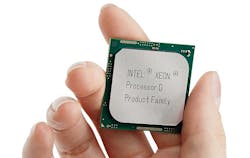High-performance embedded computing (HPEC) takes giant step forward with Intel Xeon D processor
This processor -- a rugged mobile version of the Intel Xeon server-class chip -- is bringing unprecedented digital signal processing (DSP) power to embedded computing and represents a big leap ahead of the latest Intel Core i7 processors that have become an embedded computing staple over the past several years.
The Xeon D is a mini server small enough to fit on a 3U embedded computing board, or even on a COM Express mezzanine card. Think of a computer server the size of a deck of playing cards and you get the idea of what the Xeon D brings to the table.
So what's the big deal, you might be thinking. The Xeon processor is nothing new; it's been part of those big server farms we read about for quite a long time.
The difference in the Xeon D's suitability to rugged embedded computing applications. Embedded systems designers need ball grid array (BGA) packaging in their processors for mobile rugged uses, and the Xeon offered only land grid array (LGA) packaging until the Xeon D burst on the scene last March.
Related: Hybrid processor architectures meet demands for SWaP
The conventional Xeon processor also consumes too much power and runs too hot for all but the most complex embedded computing applications. The traditional Xeon chip starts to throttle back its performance when its temperature reaches 50 to 120 Watts. This throttle-back mechanism is called thermal design power, or TDP for short.
"They are hot," says Ajit Patel, business development manager at Intel Corp. in Chandler, Ariz. The Xeon D, however, offers a TDP rating of 15 to 45 Watts, which is manageable for many high-end embedded computing applications.
While BGA packaging and manageable heat are big advantages for embedded computing, there's more in store. Intel engineers are planning for extended-temperature support for the Xeon D of -40 to 85 degrees Celsius, which puts it right in the wheel house for rugged mobile embedded computing.
Okay, so the Xeon D is rugged. What about its performance? Compare it to the Intel Core i7: the Xeon D chip has 4 to 16 separate processing units, which are called cores. The Intel Core i7 has four cores.
The Core i7 also offers an operating temperature range of 0 to 70 degrees C, which can complicate embedded computing thermal management. The extended-temperature Xeon D could be appropriate for a wider variety of embedded computing environments.
Related: The future of high-performance embedded computing
Despite its advantages in raw processing power, the Xeon D is not for everyone. The processor does not offer graphics support like the Core i7 does. "Some applications that were using the Core i7 just for computing purposes might be able to use the Xeon D," Patel says. "If you don't need a display, the Xeon D is perfect."
The Xeon D also will offer HPEC systems designers some interesting new options -- particularly for those who blend general-purpose processors like the Core i7 together with general-purpose graphics processing units (GPGPUs) for parallel processing applications.
With as many as 16 computing cores, the Xeon D is a formidable embedded parallel processing engine on its own, and could offer alternatives to the GPGPU for signal processing in applications like radar, sonar, and lidar processing; EW, and SIGINT.
Many of the major embedded computing supplies either are gearing up for Xeon D-based products, or already have Xeon D boards on the market. It's not hard to see that the new powerful chip is going to send the high-end embedded computing market in new directions.

